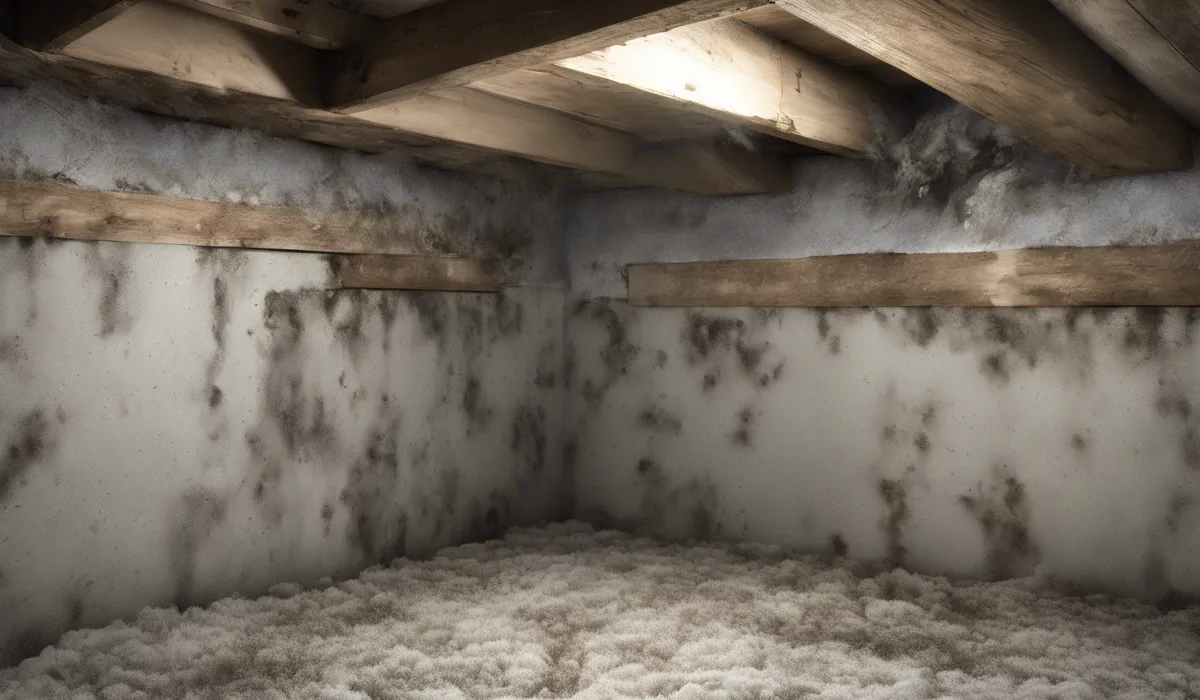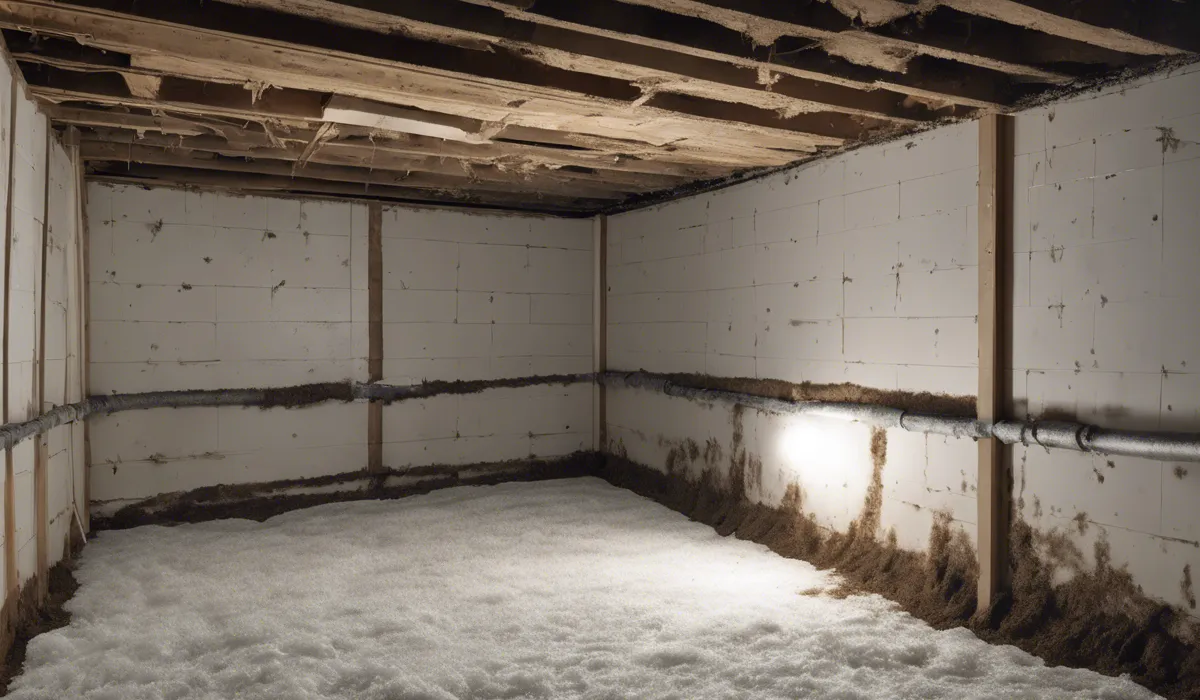No amount of mold in a crawl space is considered acceptable. Mold growth indicates moisture issues that need to be addressed to prevent structural damage and health risks.
Remediation should be undertaken promptly to maintain a safe environment.
Understanding Mold in Crawl Spaces

Definition of Mold and Its Common Types
Mold is a type of fungus that spreads through the production of spores. These tiny particles float through the air and can settle and grow on various surfaces, especially in damp and warm conditions.
In crawl spaces, the most commonly found molds include Cladosporium, Penicillium, Aspergillus, and sometimes the toxic black mold called Stachybotrys chartarum.
Each type of mold can have different effects on the crawl space and the health of those living in the home.
Conditions That Promote Mold Growth in Crawl Spaces
Mold thrives in environments where there is moisture, organic material, and warmth. Crawl spaces often provide the perfect habitat with their high humidity levels and cooler temperatures.
Factors such as leaks, poor drainage, or flooding can introduce excess moisture, which, when combined with the dark and enclosed space of a crawl area, creates ideal conditions for mold to flourish.
The Role of Moisture, Humidity, and Lack of Ventilation
Moisture is the lifeblood of mold. Without it, mold cannot grow. Humidity levels above 60% can prompt mold growth.
Lack of ventilation exacerbates the problem by trapping moist air and preventing the circulation of drier air.
When crawl spaces are not adequately ventilated, moisture accumulates and mold growth is almost inevitable.
Health Implications of Mold Exposure
Exposure to mold can lead to a variety of health issues, particularly for those with allergies or asthma.
Symptoms may include respiratory problems, coughing, throat irritation, and skin rashes.
Prolonged exposure to certain toxic molds, such as black mold, can lead to more severe health complications.
Acceptable Levels of Mold in Crawl Spaces

No Mold Is the Ideal Scenario
The absolute best scenario for any crawl space is to have no mold at all. Mold presence indicates moisture problems that can lead to structural damage and health risks.
Maintaining a mold-free crawl space is crucial for the integrity of the home and the well-being of its inhabitants.
Acceptable vs. Unacceptable Types of Mold
While no mold is acceptable, some types pose more risks than others. Non-toxic molds may not require immediate remediation but should still be addressed.
Toxic molds, like Stachybotrys chartarum, are considered unacceptable due to their potential health hazards and should be removed promptly.
Mold Spore Count and Air Quality Standards
Air quality tests can measure mold spore counts in a crawl space. Although there is no universal standard for a “safe” level of mold spores, lower counts are generally better.
Professional indoor air quality standards can provide guidance on acceptable levels.
Regulatory Guidelines and Professional Thresholds
Regulatory guidelines for mold in crawl spaces are not well-defined. However, professional organizations offer thresholds for when mold becomes a concern.
These thresholds can vary, but the consensus is that any visible mold growth should be taken seriously and dealt with appropriately.
Remediation and Prevention Strategies

Steps for Assessing Mold Infestation
To assess a mold infestation, start by visually inspecting the crawl space for visible signs of mold.
A musty smell is another indicator. It is also wise to measure humidity levels and look for sources of moisture. If mold is suspected, a professional assessment may be necessary to determine the extent of the problem.
Professional Mold Remediation Processes
Professional mold remediation involves several steps. First, the source of moisture is identified and corrected.
Then, contaminated materials are removed or cleaned. Professionals use air scrubbers and personal protective equipment to safely remove mold without contaminating other areas.
DIY Mold Removal Techniques
For small areas of mold, homeowners might opt for DIY removal. This should be done with caution, using proper protective gear and following guidelines for safe mold removal.
However, for large infestations or toxic mold, always seek professional help.
Long-term Prevention Measures
Preventing mold involves controlling moisture, improving ventilation, and conducting regular inspections.
Installing vapor barriers, using dehumidifiers, and ensuring proper drainage can all help maintain a dry crawl space.
Regular inspections will catch potential issues before they lead to mold growth.
FAQs About Mold in Crawl Spaces
What is the acceptable level of mold in a crawl space?
No amount of mold in a crawl space is considered acceptable. Any presence of mold should be addressed immediately.
Can a small amount of mold in a crawl space be ignored?
No, even a small amount of mold indicates a moisture problem and should not be ignored to prevent potential health risks and structural damage.
Is it urgent to remediate mold found in a crawl space?
Yes, it is important to remediate mold in a crawl space promptly to maintain a safe and healthy environment.
What can happen if mold in a crawl space is not treated?
If mold in a crawl space is not treated, it can lead to structural damage and pose health risks to the occupants of the home.
Who should I contact to address mold in my crawl space?
You should contact a professional mold remediation specialist or a structural engineer experienced in dealing with moisture and mold issues in homes.
Final Thoughts
Any presence of mold in a crawl space is a cause for concern, signaling underlying moisture problems.
It’s essential to address these issues promptly to avert potential structural damage and health risks. Effective remediation is crucial for ensuring the safety and integrity of the living environment.
